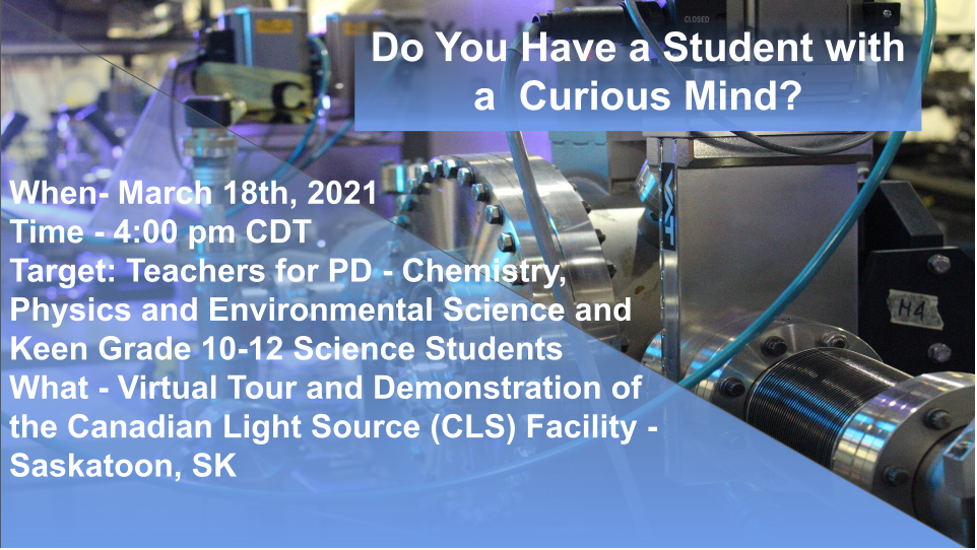< All news

STEM SKILLS FOR THE 21ST CENTURY
Nutrients for Life and Canadian Light Source are partnering for an after school workshop for high school students offered March 18th, 2021
Virtual Tour and Real – Time Soil Analysis
from the Canadian Light Source, Saskatoon, SK
Learn the Research – Participate in an Experiment
Interested in pursuing independent study and engagement in STEM along with mentorship training and leadership support? This workshop is designed for students who have a passion for Science, Technology, Engineering and Math and who are interested in a student centered, inquiry based experience that prepares them for success in STEM research and career choices. This is an opportunity for high school students, “YOU” to “DO” science.
The Canadian Light Source, located on the University of Saskatchewan’s campus will be hosting a virtual experiment to collect real-time data using one of the Synchrotron’s beamlines for an analysis of soil samples that we have provided. Students on the Beamlines (SotB) is an authentic and immersive science research experience for high school students. Through this workshop, we hope to inspire you to further engagement leading to participation in SotB where students design a scientific question/hypothesis, develop an experimental plan and potentially execute the experimental plan by visiting the Canadian Light Source, and communicate your results to the global community.
Synchrotron
A synchrotron is a source of brilliant light that scientists can use to gather information about the structural and chemical properties of materials at the molecular level. A synchrotron produces light by using radio frequency waves and powerful electro-magnets to accelerate electrons to nearly the speed of light. Energy is added to the electrons as they accelerate so that, when the magnets alter their course, they naturally emit a very brilliant, highly focused light. Different spectra of light, such as Infrared, Ultraviolet, and X-rays, are directed down beamlines where researchers choose the desired wavelength to study their samples. The researchers observe the interaction between the light and matter in their sample at the end stations (small laboratories).
A synchrotron can be used to probe matter and analyze a host of physical, chemical, geological, and biological processes. Information obtained by scientists can be used to help design new drugs, examine the structure of surfaces to develop more effective motor oils, build smaller, more powerful computer chips, develop new materials for safer medical implants, and help with the clean-up of mining wastes, to name just a few applications.
LiSSE
The Light Source Student Experience (LiSSE) is an engaging opportunity for high school students to experience a scientific investigation of everyday science that is connected to curriculum. This workshop will follow the components of the CLS LiSSE program. There are two types of LiSSE's that are offered by the Canadian Light Source synchrotron:
Beam LiSSE is only offered when there is beam available at the CLS (typically in the late fall and early spring. but subject to change). It is designed for a class to do their own investigation and conduct their experiment on the IDEAS beamline while visiting the CLS.
Problem-Based LiSSE is offered through out the year regardless if there is beam or not. It is designed for a class to investigate different aspects of science and include more of a problem-based inquiry. The class would complete their problem-based inquiry while visiting the CLS or connecting virtually if that option is chosen.
Participants will have a quick virtual tour of the CLS Synchrotron followed by a real-time analysis of soil for elemental composition that has been collected and sent to the CLS. The applications cover all the sciences, physics, chemistry, biology, environmental, including math and computer science
Learning Objectives:
Ø Identify and acquire 21st century competencies
Ø Develop foundational skills for communication; verbal, written and visual
Ø Use critical literacy strategies
Ø Incorporate wellness skills and strategies – time management, task selection and completion
Ø Learn principles of what constitutes ‘good research’
Workshop Schedule:
Virtual Workshop will run from 4:00 PM to 5:30 PM Thursday, March 18th, 2021
Ø Thursday March 18th, Soil Analysis for Elemental Composition
Presentation will include an introduction and virtual tour of the CLS followed by a real time analysis of soil samples provided to the CLS. The session will provide an opportunity for Q & A
Ø TBA Follow-up Session,
The follow up session will be based on the Questions that have been raised on March 18th with plans for a team of University researchers to address your questions in a panel format.
This event is open to interested teachers and/or students. It would be great PD for teachers and an exceptional learning event for your students with a curious mind. Many links to the skills and attitudes needed for research as well as chemistry and physics outcomes related to atomic structure and energy!
Registration will be via this Google Form. The link to the event will be emailed to the teacher contact.
For more information contact:
Tamara Sealy – Executive Director, Nutrients for Life Foundation Canada
Amanda Pfeiffer – Education Coordinator, Canadian Light Source
Nutrients for Life is supported by: